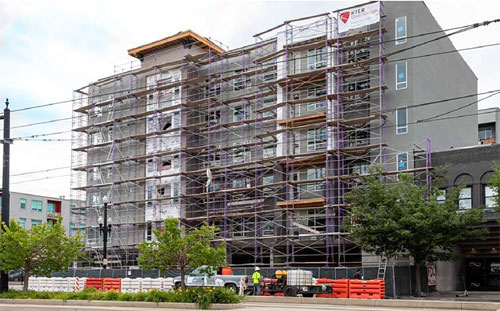Brice Wallace
People trying to find an apartment — especially at an affordable rental rate — are facing the tightest market in Salt Lake County’s history.
Research by the Kem C. Gardner Policy Institute shows a double whammy, with the 2021 vacancy rate for the county’s apartments dipping below 2 percent while rental rates jumped by double digits.{mprestriction ids="1,3"}
And all of that is happening despite a record number of rental units being under construction or proposed, following relatively slow construction earlier in the century.
“What we’re seeing now really is a response to that shortage by developers in the apartment market,” James Wood, Ivory-Boyer senior fellow at the Gardner Institute, said during the institute’s recent Newsmaker Breakfast on the apartment topic.
“It is a historic boom. I’ve followed the market for a long time and these last few years have been really very unique, unusual, and in a lot of ways, difficult really to analyze and gauge. But we’re in new territory.”
Prompting that surge in activity is that the county apartment market of nearly 148,500 units has nearly all of them occupied. Wood estimated that perhaps 3,000 are vacant. Of the 4,000 units in downtown Salt Lake City, only 42 are vacant.
The “exceptionally tight” apartment market led to 6,672 apartment units receiving building permits the past two years, out of a total of 11,037 total residential permits in the county.
Currently, 12,367 apartment units are under construction in the county, with nearly 8,000 in Salt Lake City alone. There are nearly 10,000 proposed units, with about 6,000 in the city.
“It is a bit of a challenging market to really keep track of, to really get your head around,” said Dan Lofgren, president of development company Cowboy Partners. “At one level, one would look at all this new production and think, ‘Man that’s awesome. That supply of product will bode well for affordability, the idea that there’s this volume of product coming on the market.’
“But in fact, just the opposite is happening. … There’s three or four key drivers of that, but the net result is that although we’re producing product in record numbers … the affordability of that product continues to erode.”
The building boom follows a lull from 2000-10, when the county averaged about 1,100 units receiving permits annually, or about 11,600 total. The next decade, the number tripled to 34,500. Salt Lake City saw the biggest jumps. Since 2014, 43 percent of the county’s apartment units receiving building permits have been in the city (13,400 units), and 24 percent have been in Salt Lake City’s downtown (7,500 units).
Still, Cushman & Wakefield’s August 2021 report showed a vacancy rate of less than 2 percent for all types of rental units, from studios to three-bedroom units. Rental rates grew by 10.1 percent, the second-highest yearly increase in the history of the report.
Wood said about a third of the county’s occupied housing units are in the rental market. “For a lot of people, it’s their only alternative,” he said.
That’s because the median price of a Salt Lake County single-family home is $585,000, up 27 percent during the past year. Using a traditional model, a person would need an income of $115,000 to buy that home. “And that puts pressure on the rental market,” Wood said.
The U.S. Department of Housing and Urban Development’s Comprehensive Housing Affordability Strategy shows that 41 percent of renter households in 2018 were paying 30 percent or more of their income for housing and utilities.
Lofgren said that even among “lifestyle” renters — those choosing to rent rather than being force into it — are seeing a larger percentage of their household income being dedicated to housing costs. Throughout the county, he said, renters are moving up to higher-level apartments, but the apartments they are leaving behind still may not be affordable to most people.
Mark Jensen, executive vice president of Colliers International, said many apartments were renovated, thus resulting in higher rents, between 2012 and 2018. The continuation of more high-end housing, he said, “will change our market, for sure.”
Wood noted that the affordability crunch is most severe in downtown Salt Lake City, with rents there being 30 percent to 40 percent higher than in suburban areas. “In the downtown market, there is very little … that’s going to be affordable to even the median-income renter,” he said.
The good news for Salt Lake County renters is that the building boom should help with vacancy rates. The number of rental units, currently 148,500, is projected to balloon to 166,667 in 2024. Even with the number of renter households expected to grow from the current 145,500 to 157,200, the number of vacant units is expected to grow from the current 3,000 to nearly 8,500, with the vacancy rate moving up from 2 percent to 5.7 percent.
The double-digit rental increases likely will continue through 2022 and moderate a bit in 2023, Wood said. By 2024, it likely will shrink to 5.5 percent or so, a more traditional rate.
“I think that what we’ll see is some relief over the next three years for the renter,” Wood said. “It will still be a landlord’s market, but we’re going to see a little bit of tempering of rental rate increases.”
The full Gardner Institute report is at https://gardner.utah.edu/wp-content/uploads/AptMrkt-Zions-Mar2022.pdf.{/mprestriction}








